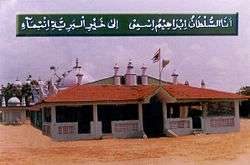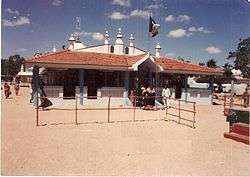Erwadi dargah
| Erwadi Dargah | |
|---|---|
 Erwadi dargah ஏர்வாடி தர்கா | |
| Basic information | |
| Location | Erwadi, Tamil Nadu, India |
| Geographic coordinates | 9°15′00″N 78°51′04″E / 9.25°N 78.851°ECoordinates: 9°15′00″N 78°51′04″E / 9.25°N 78.851°E |
| Affiliation | Islam |
| Region | Erwadi, Ramanathapuram district |
| Architectural description | |
| Architectural type | Dargah |
| Architectural style | Islamic architecture |
| Completed | 18th century |

The Erwadi dargah is a holy Islamic sacred tomb turned shrine of Qutbus Sultan Syed Ibrahim Badusha, also spelled Saeed Ibrahim Uliullah or Seyyad Ali. It is located in the Erwadi village in Ramanathapuram district in India.[1] The main dargah which came to be established is dedicated to Seyyad Ali. There are three other dargahs here, one of Shahid's mother Fathima, the second is of his wife Seyyad Ali Fathima and the third of his son Abu Thahir.[2] The land for building the darghas was a gift from the Maharaja of Ramanathapuram and dargha, and the Nawab of Arcot built the main dargah in the Arab year of 1207 and named it Ektibagh.[1]
The dargah is well known for healing mentally deranged people, and about 1,000 devotees of all religious beliefs visit the shrine every day.[3] The cure offered to the sick people is only the holy water from the dargha twice a day, apart from prayers.[1]
History
Saeed Ibrahim Uliullah, also called Quthbus Sultan Syed Ibrahim Shaheed Valiyullahal, king from Saudi Arabia (it is also said that he was from Morocco[3]), came to Erwadi during 530 Hijri year when it was under the reign of Maharaja Vijaya Regunatha Sethupathi, King of Madurai. He came with intent to preach Islam.[1][3][4] The Sultan performed many magical feats which impressed the king who then gifted him with 6,000 acres (2,400 ha) of land.[4] However, it is said that king was blessed with an heir when he prayed and drank the holy water at the dargah for 41 days.[3] Following this Hindus of the village, impressed with the miracles performed by the Sultan, wanted to convert to Islam. At that time the king who had succeeded Sethupathi was Vikrama Pandya who opposed this conversion of Hindus. As a result of this opposition there was a battle between the Seyyad Ali and Vikrama Pandya in which the former was killed along with members of his family including his son who was only of 17 years age. Seyyad Ali became a martyr and the tomb where he was buried became a dargah or saintly place. People have great trust in the magical powers of the dargha which has resulted in unity among the Muslim and Hindu communities. The shrine has become a very popular place for healing mentally deranged people as it is believed that the water and the oil from a lamp from the dargha has spiritual healing powers and is administered to the sick people.[3][4]
According to a local legend, after Shaheed Valiyullah (Seyyad Ali) died in 1198 his descendant Nalla Ibrahim Valiyullah had a dream in which Valiyullah was directed by the saint to build a dargah in his memory at the particular place. Valiyullah then built the dargah and his descendent are maintaining it now.[3]
Tragedy and medical care
Twenty five mentally sick people who were undergoing spiritual treatment at the Dargah and who were chained together died in 2001 in a severe fire accident at the venue. Following this tragedy Government of Tamil Nadu opened a 50-bed hospital called "Dawa-Dua" in November 2012, in a 1 acre (0.40 ha) land next to the dargah donated by the Dargah Haqdhar Management Committee. Apart from the spiritual cure provided by the dargah, mental healthcare medicine is provided to enable patients recover faster. The patients are not chained now.[5][6][7]
Festival
An annual festival commemorating the martyrdom of Seyyad Ali is held at Erwadi in the Islamic calendar month of Dulkahath, and the festival (the 841st festival in 2015) is named "Chandanakkudam" or "sandhanakoodu" when the tomb of the saint is given a coat of sandalwood paste. On this occasion a religious flag is hoisted over the dargah, and the right to hoist this flag rests with the local Hindu communities of Karuppaiah Yadavas, Ambalathar, Nadar and Vanniar. It marks a symbol of religious harmony when a very large number of people of all faith attend the festival.[4][8]
References
- 1 2 3 4 Jain, Madhu (15 October 1987). "Prisoners of the mind". India Today. Retrieved 7 October 2015.
- ↑ Pal 2014, p. 129.
- 1 2 3 4 5 6 Krishnakumar, Asha (August 2001). "Deliverance in Erwadi". Volume 18 – Issue 17. Frontline, India’s national Magazine.
- 1 2 3 4 Raghavan, T. S. Sreenivasa (8 August 2001). "Erwadi dargah has a history of 400 yrs". The Times of India. Retrieved 8 October 2015.
- ↑ "50-bed hospital to come up near Erwadi dargah". The Hindu. 20 February 2014. Retrieved 9 October 2015.
- ↑ Kumar, S. Vijay (7 December 2013). "Erwadi mixes prayer and medicine". The Hindu. Retrieved 9 October 2015.
- ↑ "Release from chains at Erwadi dargah thanks to 'Dawa-Duwa'". The Hindu. 16 May 2015. Retrieved 9 October 2015.
- ↑ "Sandhanakoodu festival". The Hindu. 16 December 2006. Retrieved 9 October 2015.
Bibliography
- Pal, Susant (5 February 2014). Imbibed In Faith. Partridge Publishing India. ISBN 978-1-4828-1259-6.